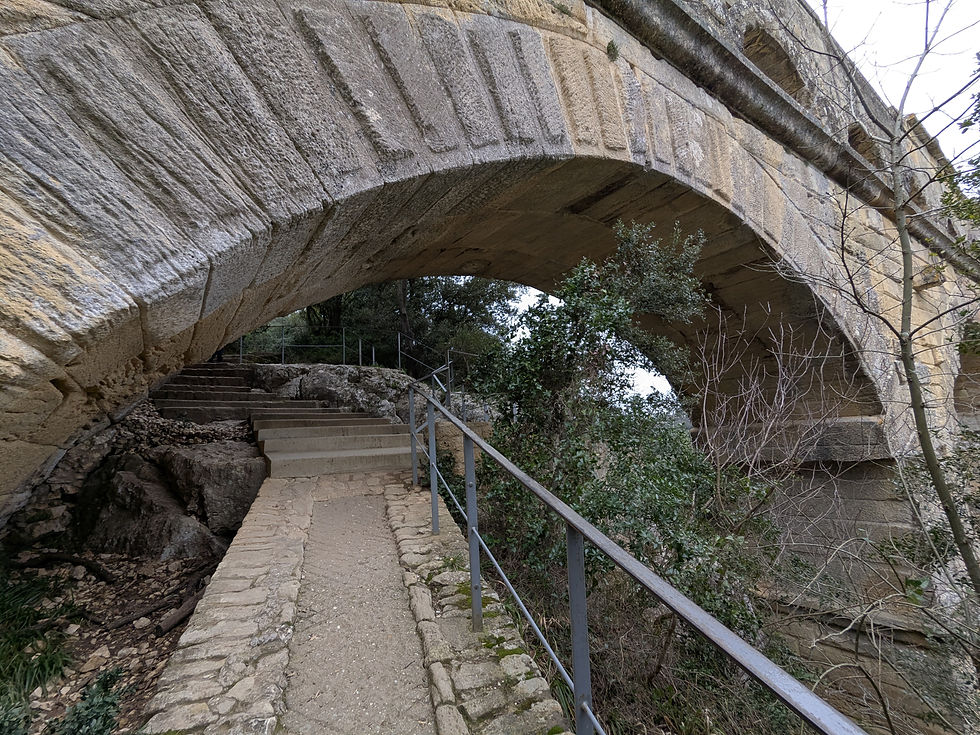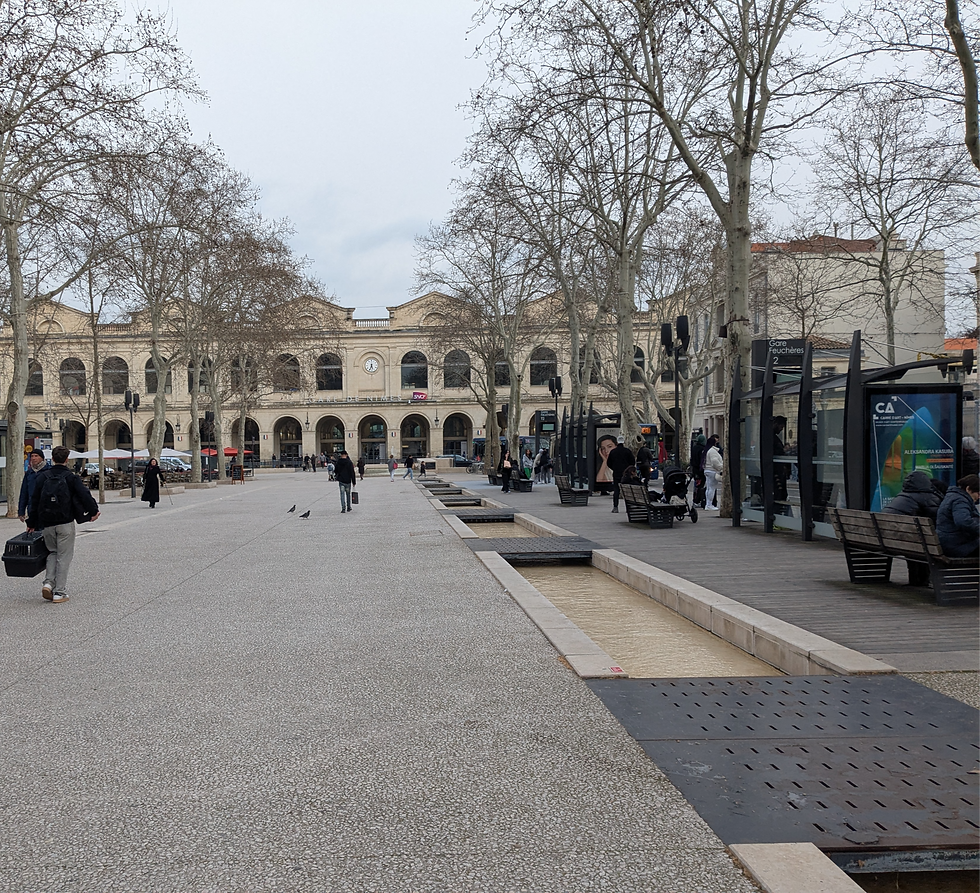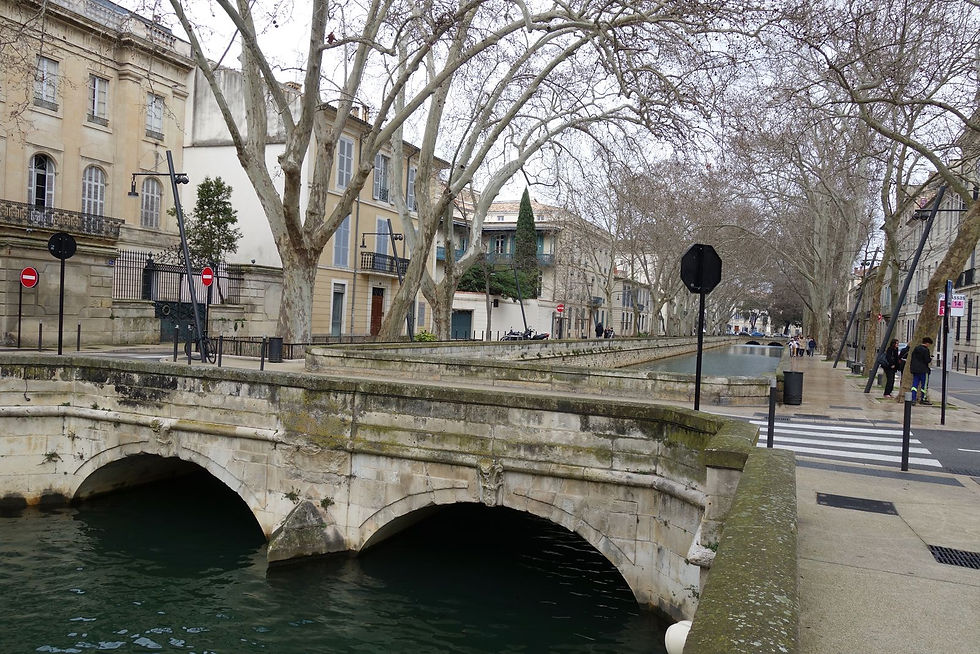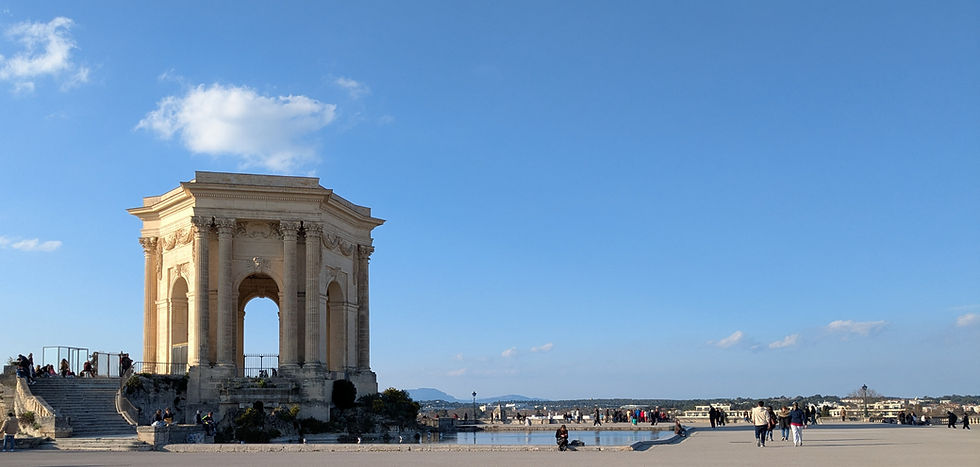Provence and Occitanie: Day 9
- lendroitheureux
- Jul 19
- 13 min read
Updated: Aug 18
Pont du Gard and Nimes: Roman Ruins, Crocodiles, Naming Nimes Cheeses, and the Best Park Ever!

Our next day out and about in Southern France was down highway A9 to the city of Nimes. Note that I said “Southern France” and not “Provence” this time. Nimes is actually a wee little bit outside of Provence in the Occitanie region. Thus the title of this group of posts. Later in our trip, we meandered to Montpellier, also located in Occitanie. I would not want to mislead the reader. I never do that. Our morning’s drive also led us to Pont du Gard, an ancient Roman aqueduct right off the main highways, more or less between Nimes and Avignon. This day would be a Roman festival. A festival of Roman delights? A toga party? Whatever, let’s roll! Allons-y! Depechez-vous!


Pont du Gard, just under a half-hour drive due west from Avignon, is a large stone aqueduct over the Gardon river and is considered one of the greatest (if not the best) extant examples of a Roman aqueduct. It is enormous, with three arched levels rising about 160 feet over the rushing Gardon. There are unique aspects that make this structure remarkable and set it apart from other massive Roman aqueducts I have come across in the wild (of which there are zero). The most mind-boggling of them all is that the entire thing—arches, sluices, bridge and all—was constructed without mortar. Nothing holds it together besides gravity. No glue. No stickums. Nothing. The Romans certainly had some know-how. Pretty amazing for something created in the first century.

If you are in the area and have transportation (there are tour buses from every major metro area), Pont du Gard must be on your itinerary. Entry to the site is “free,” but there is a 9-euro parking fee, which seems about par for the course in terms of paying for these spectacular sites. You can spend 10 minutes or closer to 2 hours (as we did) walking around the aqueduct and climbing the hills on either side for unforgettable views. There is a museum we didn't visit, but I have read that it's quite informative and has a great view.

One easy-to-miss feature of Pont du Gard are the various carvings in the stone that you will pass while crossing the bridge. These aren’t original Roman decorations, rather they appear to be “graffiti” left behind in recent centuries (the last three or four centuries) by people who either were working on preserving the bridge or stonemasons who visited and wanted to leave their literal mark. Each carving includes a hammer mason tool design, a name, and a date. I saw quite a few of them and think they are dandy.
There are also hiking trails and a remarkable cave (Grotte de la Salpetriere) that surely housed prehistoric “cave people” dressed in animal hides, carrying clubs while grunting and pointing. My historical analysis is correct, and remember, I never mislead the reader. In all honesty, there have been archaeological finds that point to human activity in the cave that date to the Paleolithic Period. That's a long time ago. So perhaps the club-wielding, skin-wearing grunt motif is not too far off.

Pont du Gard is accessible. The walkway to the aqueduct is very smooth and flat, and anyone with mobility issues will be able to get right up close and personal with the bridge. There are stairs and the aforementioned trails, so there will be areas that are inaccessible or more difficult, but you will be able to have the main experience. My unasked for advice: Go to Pont du Gard!
After glorying in the grand gargantuan gorge gap of Pont du Gard, we hopped back into the BMW rental car and zipped down highway D6806 for about a half hour and landed at the Nemausus Station parking garage. The garage is located directly behind the central Nimes train station in an apartment/hotel/commercial complex. A short walk through the complex and the train station, and behold: Esplanade du General de Gaulle! You will be graced with the long pedestrian boulevard of Avenue Feucheres, with its fountain directly across from the train station and small concrete water channels built into the road running the length of the promenade. Water is everywhere in Nimes, and if you enjoy fountains and canals mixed into an urban landscape complete with Roman ruins, this is the place for you!

At the large plaza, Esplanade Charles de Gaulle, the Roman Arena at Nimes looms just off to the west. Directly in the center stands a marvelous fountain, Fontaine Pradier. I talk about fountains a lot in this blog, but they are often so intricate and fun to behold that I just can't get enough. Unfortunately, as I've also mentioned, many of the fountains we came across on this trip were not running. A consequence of the month we visited, no doubt. But this fountain was bubbling away, much to my everlasting joy!

Fontaine Pradier is fascinating in that the humans on the structure aren't memorials for actual people or even deities. The standing human at the top is the personification of the city itself, and the four other figures represent the four hydraulic sources the city thrived upon: natural springs of Nimes and Eure, the Rhone, and Gardon river (where Pont du Gard stands). While I was contemplating this most contemplative and fun fountain, I realized that I was a cranky yankee and getting hangry (both scientifically classified terms). The boulevard and plaza are lined with cafes and restaurants, so it was simple for us to choose a place and stop into a nice little restaurant for a little lunch.


Le Goeland restaurant sits across Boulevard de la Liberation from the plaza and serves up very delicious galettes (a round, flat pastry similar to a crepe but filled or topped with something savory instead of sweet). I got the quatre fromages, and Lani opted for the coque madam. This dejeuner featured one of the highlights of my entire vacation. After we had completed our fine meal and the kind server came out to collect our plates, I asked, in French, whether or not I could try to name all four of the quatre fromages in my galette. The server complied, and (all in French) we had a short conversation wherein I named Gouda, Roquefort, and Parmesan in order, with each cheese garnering a “oui” and a look of pleasant surprise and “tres bien” from the server. I was unable to guess the last fromage, and the server explained that it was a local goat cheese. I never would have landed on local provincial goat cheese. The server was pleased with my cheese work, as was I. I haven’t shut up about it since.

I rode my fromage victory all the way across the plaza to the Roman arena, into which I strode like a true gladiator, ready to do battle and name many cheeses!

We purchased the Nimes la Romaine city pass for 14.50 euros. It gives access to three ruins (Arena, Maison Carree, Tour Magne) and offers ease of entry. It was lightly raining when we set out to the arena, but that didn’t dampen our experience or joy. Much like the arena in Arles, the Nimes colosseum is still used today for various events. There is even a statue of a bullfighter in a plaza out front. You can get right down on the dirt floor of the arena and climb all the way up to the top for nice views of the city. This is a marvelously preserved colosseum. Although it has the modern metal benchwork, scaffolds, and railings just like in Arles, these don’t seem quite as intrusive as those in Arles. The view of the arena from the top is just about as perfect as one could expect.

We had almost the entire place to ourselves. No crowds on this rainy March day, and we never had to elbow our way through the corridors or stone stairs. It was quite peaceful. There were even couples sitting up high on the stone benches having chats and simply spending a day. There are informational posters throughout the arena in the outer corridor, explaining the various types of gladiators and the weapons they used. The images are quite exciting and action-packed. I don’t know the extent of the veracity of these posters, and the images and weaponry therein, but hey, you gotta entertain the youngsters (and me) somehow.

While at the arena, I learned that the word “vomitories” is in use at Roman arenas and has nothing to do with bacchanalia, binging and purging, or decadent overeating. There are signs reading “Vomitories” with arrows and numbers (as in seating areas) throughout the corridors in the Nimes arena. This refers to the process of herding crowds of people at an event in a facility to a small bottlenecked area and then out of that area. Thus, the people are “vomited” out of the arena. No actual throw-up involved. Unless some bullfighting hooligans imbibed too much Nimes beer. Then all bets are off, and you might witness some vomit in the vomitories while you are vamoosing the event. The arena in Nimes is fantastic.

Throughout Nimes, you will notice many crocodile motifs. There are images of crocodiles on the doors of the Arena, medallions in the stone sidewalks, and all manner of shops, boutiques, and municipal buildings. The crocodile is part of the city’s lore and, along with a palm tree, the city crest.


Back in 30s BCE, the Romans waged a military campaign in Egypt (hello Antony and Cleopatra), and many soldiers on that campaign were from Nimes. Upon returning, these Nimois soldiers brought tales of crocodiles, and the Roman Empire celebrated the victory in the Egypt campaign with commemorative coins. Over time, the crocodile and palm have become the symbol of Nimes. One of the best examples is the Fontaine du Crocodile in Place du Marche. I was very excited about seeing La Fontaine de Crocodile, and it did not disappoint! Simply splendid.
We strolled on through rainy Nimes, careful not to slip and slide on the wet cobblestones as we visited Place de l’Horloge, Place aux Herbes, and Cathedral de Notre Dame et Saint-Castor. We made our way to the next grand Roman relic, La Maison de Carree.


The Maison Carree is a large, rectangular, columned Roman temple with a peaked roof, set atop a large base with many stone stairs. It sits in a rather vast plaza, otherwise empty, in the heart of modern Nimes. It’s somewhat incongruous to its surroundings but nevertheless fascinating and a must-see in Nimes.



The Maison Carree is dedicated to the imperial cult and was constructed (along with the other Roman monuments apart from the colosseum) during the reign of the founder of the Roman Empire, the first emperor, Caesar Augustus (63 BCE-14 AD). Incorporating the pagan god Nemausus (namesake of the town) into the imperial cult, the temple and forum complex (where Carree sits) integrated the spring that brought water to Nimes which was also, at a distance, connected to Pont du Gard. It all connects and comes full circle.
If my explanation is not sufficient, travel to Nimes and read the placards at Maison Carree, because that is where I am getting my info. All the monuments in Nimes have excellent historical contextualization in both French and English. The Maison Carree is rather small. Its one room holds an informative museum about the Maison's history, meaning, architecture, and uses throughout the years. It is included in the Nimes la Romaine city pass, so there is really no reason to pass it up. It may get quite crowded inside, as it did on this non-touristy day. The outside is the best aspect of the Maison Carree anyway. The stairs are steep and without railings, so watch your step, especially on a rainy day.
From Maison Carree, we walked a few blocks to a pretty canal that flows along Quai de Fountaine. This is the ancient natural spring responsible for the fact that this area was settled in prehistoric times. We followed the canal on Quai de Fontaine, crossed the bridge at Rue Agrippa, hung an immediate left, and behold! We arrived at what is the most stunningly beautiful park I have ever seen in my life, and I have seen parks in Paris.

Jardins de la Fontaine is large, stretching for over 37 acres with the aforementioned canal looping through the center, and features pools, ponds, stone walkways, promenades, multileveled landings, numerous statuary and fountains. The plants throughout abound! We visited in winter, and the flora was still abundant. While most of the trees were sans leaves, there were still plenty of evergreens, palms, and various shrubbery to gawk at. Koi filled the pond, swans swam, and people played boules.


A Roman ruin, the Temple of Diana, sits on the western edge of the lower park, below the steep Mont Cavalier, a hill that overlooks the park and indeed the entire city. It is unclear whether the structure was an actual temple, since many believe it may have been a library. It is also unclear whether it was constructed during the reign of Augustus (1st century) or in the following century. Regardless, this is a special site.

It sits open and free to all. You can wander in and explore the vaulted ceilings, some original stone carvings, arched passages, and various chambers. The fact that in this large, modern urban space, one can simply wander into a two-century old Roman maybe temple-maybe library is not even comprehensible. A small garden of what I am assuming are local plants is tucked into one of the empty spaces surrounded by stone walls.


And if the fountains, canals, pools, and Roman ruins aren’t enough to fulfill your Nimois park appetite, all you have to do is turn to the north and walk up. And up. And up. And across and then up. And up some more. Mont Cavalier stands as the highest point in Nimes. As you mosey your way up, across, and up some more (the path zigs and zags across the face of the large hill), you will come across the lush waterfall fountain “Emplacement du Bassin de Montgolfier” which roughly translates to “location of the hot air balloon pool.”

The Montgolfier brothers were the inventors of the hot air balloon. But I cannot figure whether or not they spent any time in Nimes, let alone did a balloon flight there. One of the brothers, Joseph-Michel, invented a hydraulic pump mechanism, so perhaps this is testament to that. After all, Nimes is all about the water. One can ponder on these and other mysteries here, as the view of the park and Nimes from a spot just above are quite fantastic.

Speaking of fantastic views, once we climbed our way up Mont Cavalier, we reached La Tour Magne (the Magne Tower). It was originally a site of importance to those old-timey pre-Roman Gauls. The Romans, under Emperor Augustus, built it up as a part of the city’s walled defenses. It’s now 105 feet tall and has 140 winding steps to the top. If you are able and can handle the height, pay the entry fee (it’s included in the Nimes la Romaine pass), and take a gander at the view. Nimes, with all its glory (the arena is very visible), stretches out from the park and offers a view that you won’t forget and will make the 140-step climb worth the effort. Avenue Jean Jeaures, with tree-lined sidewalks and canals, is particularly special.


While the stairs are modern, they are still spiral and will take some effort to ascend and even descend. The reason for the reconstructed interior to the tower is somewhat humorous, somewhat tragic, and has to do with a friend of the blog from the Provence and Occitanie: Day 8 post, Nostradamus. Only about a half-century after the death of the ole soothsayer of Saint-Remy, a local farmer named Francois Traucat was granted permission by King Henry IV to strip the interior of the tower and dig around inside in order to find a treasure supposedly prophesied by Nostradamus. Of course there was no booty to be found, and the tower had to be repaired, thus some of the more modern aspects within.



After our journey to Nimes on high, we had to find our way down the hill. In my itinerary planning brilliance, I opted to not plan for a nice casual stroll down the hill the way we came so we could pass through the fine garden park once again and gaze upon its fountains and canals. I opted to not include the (most likely) gorgeous Avenue Jean Jauries, with its plane trees and canals. No, my wise decision making led me to choose a walk down the east side of the hill. We wound through and past a children’s playground and into a residential neighborhood bustling with families and students heading home on a Friday evening. I did this artful itinerary customization because there was a kind of off-the-way item I thought would be neat to see.
As if we hadn’t seen enough Roman ruins, I wanted to see a small spot right outside the fortress that is Nimes University called Castellum Aquae, the remains of a holding tank for water arriving from a natural spring via aqueducts. It used an ingenious type of Roman engineering to channel the water through several sluice gates to various locales throughout Nimes. It’s a really cool spot to see, entirely free (it’s behind a fence, so you can’t prance around inside), and holds a special treat we weren’t prepared for: cats! We love cats (I have two), and seeing a number of fuzzy felines feeling free inside these ruins was so great. They had food in dishes, a litter box, and even a little home in which to sit and scowl at passers-by (as one did toward us). The Castellum Aquae was our last site in Nimes and a good way to end the day on a purr-fect note (I am SO sorry for that).
Our time in Nimes and Pont du Gard was magnificent. Before planning this trip, I had no idea the extent of Roman ruins in Southern France and just how well preserved they are. Maison Carree is easily one of the best kept examples of a Roman structure anywhere in the world. The arena and aqueduct are simply stunning, and if you don’t want to battle so many crowds in actual Rome, go to Nimes. They speak French there, which is pleasing to the ear, so there’s that. Also, the best public park ever is in Nimes!

When we returned to Avignon and parked the car under the Pope’s place, we once again stopped by the local grocer then dined in our room on small French treats. We hit the hay ready for rest, because an early Saturday rise was up next, as our longest drive to the Camargue was looming. And we were excited! Stay tuned for the next entry on all things Camargue, salt, and Sainte-Sara.





















Comments